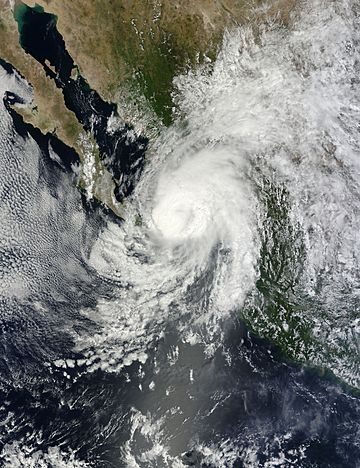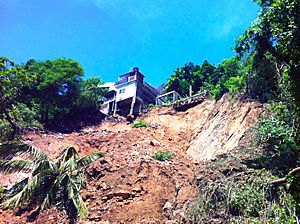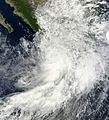Hurricane Manuel facts for kids
| Category 1 hurricane (SSHWS/NWS) | |

Tropical Storm Manuel near hurricane strength on September 18
|
|
| Formed | September 13, 2013 |
|---|---|
| Dissipated | September 19, 2013 |
| Highest winds | 1-minute sustained: 75 mph (120 km/h) |
| Lowest pressure | 983 mbar (hPa); 29.03 inHg |
| Fatalities | 123 total |
| Damage | $4.2 billion (2013 USD) (Costliest Pacific hurricane on record) |
| Areas affected | Oaxaca, Guerrero, Michoacán, Colima, Jalisco, Sinaloa, Texas |
| Part of the 2013 Pacific hurricane season | |

Hurricane Manuel was a powerful tropical cyclone that hit western Mexico in 2013. It formed on September 13 and lasted until September 19, 2013. What made Manuel special was that it hit Mexico at the same time as another big storm, Hurricane Ingrid, which came from the other side of the country. This caused a lot of problems for Mexico.
Manuel caused a lot of damage, costing about $4.2 billion (in 2013 money). Sadly, about 169 people lost their lives because of the storm.
Contents
What Was Hurricane Manuel?
Hurricane Manuel started as a tropical depression off the coast of Mexico. A tropical depression is like a baby hurricane, with winds that are not very strong yet. It quickly grew stronger, becoming a tropical storm and then a hurricane. Hurricanes are huge storms that form over warm ocean waters. They have very strong winds and bring heavy rain.
Manuel's Path and Strength
Manuel moved slowly along the Pacific coast of Mexico. It brought heavy rains and strong winds to many states. Even though it was a Category 1 hurricane, which is the lowest hurricane strength, it caused a lot of trouble. This was mainly because it moved so slowly and dropped so much rain. The storm also weakened and then got stronger again, which is unusual for a hurricane.
How Manuel and Ingrid Caused Double Trouble
Imagine two big storms hitting a country at the same time! That's what happened to Mexico in September 2013. While Hurricane Manuel was hitting the Pacific coast, Hurricane Ingrid was hitting the Atlantic coast. This meant that rescue teams and aid workers had to help people in two different parts of the country at once. It made the disaster much harder to manage.
Manuel's Impact on Mexico
Hurricane Manuel caused widespread damage across several Mexican states. The heavy rainfall led to massive floods and dangerous landslides. Many homes, roads, and bridges were destroyed or badly damaged.
Flooding and Landslides
The biggest problem from Hurricane Manuel was the rain. It rained so much that rivers overflowed their banks. Many towns and cities were completely underwater. The ground became very soft, leading to landslides. These landslides swept away homes and blocked roads, making it hard for people to escape or for help to arrive.
Affected Areas
The states most affected by Manuel were Guerrero, Michoacán, and Sinaloa. The city of Acapulco, a popular tourist spot in Guerrero, was hit very hard. Many people were stranded there because the roads were blocked by floods and landslides. The Mexican government had to send planes and boats to rescue people.
Government Response
The Mexican government, led by President Enrique Peña Nieto, worked hard to help the people affected by the storm. They sent aid, food, and water to the damaged areas. They also helped to clear roads and rebuild homes. It was a huge effort to recover from such a big disaster.
Images for kids
-
President Enrique Peña Nieto and Secretary of the Interior Miguel Ángel Osorio Chong visit affected zones around Acapulco de Juárez on 16 September 2013.
See also
 In Spanish: Huracán Manuel para niños
In Spanish: Huracán Manuel para niños




